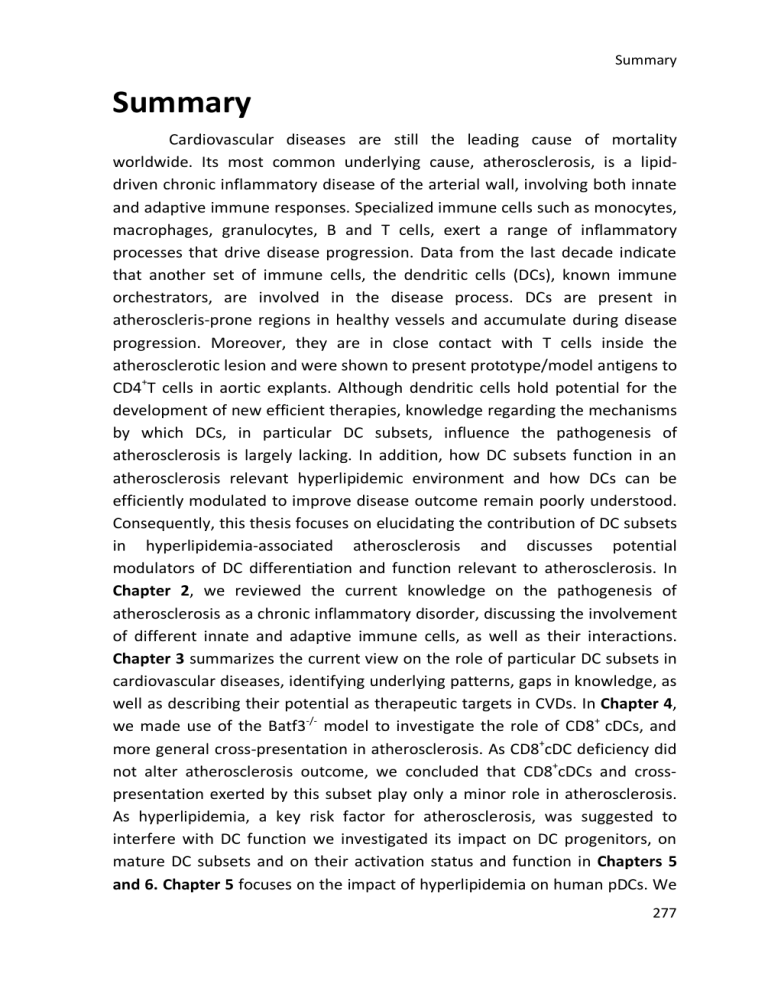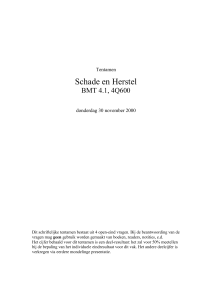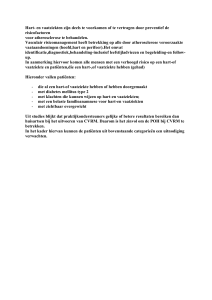
Summary
Summary
Cardiovascular diseases are still the leading cause of mortality
worldwide. Its most common underlying cause, atherosclerosis, is a lipiddriven chronic inflammatory disease of the arterial wall, involving both innate
and adaptive immune responses. Specialized immune cells such as monocytes,
macrophages, granulocytes, B and T cells, exert a range of inflammatory
processes that drive disease progression. Data from the last decade indicate
that another set of immune cells, the dendritic cells (DCs), known immune
orchestrators, are involved in the disease process. DCs are present in
atheroscleris-prone regions in healthy vessels and accumulate during disease
progression. Moreover, they are in close contact with T cells inside the
atherosclerotic lesion and were shown to present prototype/model antigens to
CD4+T cells in aortic explants. Although dendritic cells hold potential for the
development of new efficient therapies, knowledge regarding the mechanisms
by which DCs, in particular DC subsets, influence the pathogenesis of
atherosclerosis is largely lacking. In addition, how DC subsets function in an
atherosclerosis relevant hyperlipidemic environment and how DCs can be
efficiently modulated to improve disease outcome remain poorly understood.
Consequently, this thesis focuses on elucidating the contribution of DC subsets
in hyperlipidemia-associated atherosclerosis and discusses potential
modulators of DC differentiation and function relevant to atherosclerosis. In
Chapter 2, we reviewed the current knowledge on the pathogenesis of
atherosclerosis as a chronic inflammatory disorder, discussing the involvement
of different innate and adaptive immune cells, as well as their interactions.
Chapter 3 summarizes the current view on the role of particular DC subsets in
cardiovascular diseases, identifying underlying patterns, gaps in knowledge, as
well as describing their potential as therapeutic targets in CVDs. In Chapter 4,
we made use of the Batf3-/- model to investigate the role of CD8+ cDCs, and
more general cross-presentation in atherosclerosis. As CD8+cDC deficiency did
not alter atherosclerosis outcome, we concluded that CD8+cDCs and crosspresentation exerted by this subset play only a minor role in atherosclerosis.
As hyperlipidemia, a key risk factor for atherosclerosis, was suggested to
interfere with DC function we investigated its impact on DC progenitors, on
mature DC subsets and on their activation status and function in Chapters 5
and 6. Chapter 5 focuses on the impact of hyperlipidemia on human pDCs. We
277
Summary
demonstrated that human pDCs engulf lipids when exposed to excessive
amounts of LDL or oxLDL in vitro, resulting in ablation of Toll-like receptor 7
and 9 induced pDC activation as witnessed by quenched production of proinflammatory cytokines as well as by downregulation of maturation markers.
Eventually, oxLDL- abrogation of pDC activation resulted in impaired CD4+ T
cell polarization. In Chapter 6, we addressed the early adaptive effects of
hypercholesterolemia in DC (precursor) homeostasis, on DC lipid accumulation
and on its consequences for T cell priming capacity in vivo. Our results indicate
that HFD feeding augments MDP proliferation and numbers, but did not affect
DC subset numbers in lymphoid compartments. However, HFD resulted in lipid
accumulation by CD8-, and to a lesser extent CD8+ conventional DCs (cDC), but
not plasmacytoid DCs (pDCs). Lipid loading resulted in increased costimulatory
molecules expression, accumulation, and baseline TLR activation-associated
cytokine release (IL-1β, IL-6, TNF-a) by CD8- cDCs, but caused a reduction in
CD8-DCs’ capacity to stimulate naïve CD4+ T cells. Whether hyperlipidemia
results in impaired host’s defense against pathogens in humans remains
elusive. In Chapters 7 and 8, we investigated potential targets to modulate DC
function in order to improve atherosclerosis disease outcome. Chapter 7
focused on the role of the RNA-binding protein Quaking (QKI) in DC
development and function, and its impact on atherosclerosis. We used a model
in which QKI was conditionally deleted in CD11c expressing DCs. QKI deficiency
resulted in reduced DC generation and proinflammatory cytokine production
by DCs in vitro and skewed DC differentiation towards CD8-DC in vivo. CD11crestricted loss of QKI indirectly resulted in a CD8+ shifted T cell profile and
decreased CD4+ Th17 to Treg ratio. In the context of atherosclerosis, CD11c
restricted loss of QKI expression attenuated plaque development and necrotic
core size formation, indicating the potential as a target for therapy. In Chapter
8, we show that constituve activation of CD40 signaling in DCs reduced
atherosclerosis by strong intestinal inflammation resulting in reduced
cholesterol levels, a critical driver of atherosclerosis. Finally, Chapter 9
summarizes and discusses the most important findings of this thesis and
defines the most relevant outstanding questions and future perspectives.
278
Summary
Altogether, this thesis provides novel insights into the biology of DC
subsets in atherosclerosis, establishing
the profound impact of
hypercholesterolemia on DC function and a minor relevance for crosspresentation and CD8+DCs in the disease process. Moreover, we identified two
interesting avenues for further research in DC modulation as potential therapy
for cardiovascular disease.
279
Samenvatting
Samenvatting
Hart- en vaatziekten (HVZ) zijn tot op heden nog steeds de
belangrijkste doodsoorzaak wereldwijd. Het meest voorkomende
pathologische proces dat hieraan ten grondslag ligt is atherosclerose.
Atherosclerose is een lipide gedreven chronische ontstekingsziekte van de
vaatwand, waarbij zowel aangeboren als verworven immuunreacties een grote
rol spelen. Gespecialiseerde immuuncellen, zoals monocyten, macrofagen,
granulocyten, B en T cellen, zijn verantwoordelijk voor een groot aantal
ontstekingsreacties die samen bijdragen aan de progressie van de ziekte. Uit
bevindingen van de laatste tien jaar blijkt dat ook een andere groep
immuuncellen, namelijk de dendritische cellen (DCs), betrokken zijn in het
ziekteproces. DCs zijn sleutelfiguren in het regelen van het immuunsysteem en
het koppelen van aangeboren en verworven immuunreacties. Ze zijn aanwezig
in atherosclerose-gevoelige gebieden van gezonde bloedvaten en stapelen
daar op naarmate de ziekte verergert. Bovendien worden ze in
atherosclerotische leasies aangetroffen in nauw contact met T cellen en heeft
men aangetoond dat ze in gedissecteerde aortas in staat zijn om
prototype/model antigenen te presenteren aan CD4+ T cellen. Hoewel
dendritische cellen potentieel hebben voor het ontwikkelen van nieuwe
efficiënte behandelingen ontbreekt voor een groot deel de kennis van de
mechanismen waarbij DCs, en in het bijzonder hun specifieke subsets, de
pathogenese van de ziekte beïnvloeden. Verder is er nog maar weinig bekend
over hoe DC subsets functioneren in een ovematig vetrijke omgeving (relevant
in atherosclerose) en over hoe DCs efficiënt kunnen worden beïnvloed om de
uitkomst voor de patient te verbeteren. Dit proefschrift focust dan ook op de
bijdrage van DC subtypes tot hyperlipidemia-geassocieerde atherosclerose.
Daarnaast bespreken we potentiële regelmechanismen van DC ontwikkeling en
functie relevant voor de behandeling van atherosclerose. In hoofdstuk 2 geven
we een overzicht van de stand van zaken over de pathogenese van
atherosclerose als chronische ontstekingsziekte. Hierbij wordt zowel de
betrokkenheid van, alsook de onderlinge interacties tussen, cellen van het
aangeboren en verworven immuunsysteem besproken. Hoofdstuk 3 beschrijft
de huidige kennis over de rol van DC subtypes in HVZ. Hierbij ontrafelen we
onderliggende patronen en brengen we tekortkomingen en mogelijkheden van
DCs als therapeutische targets in HVZ in kaart. In hoofdstuk 4 maken we
281
Samenvatting
gebruiken van het Batf3-/- model om de rol van CD8+cDCs, en meer algemeen
kruis-presentatie, in atherosclerose te bestuderen. Gezien verlies aan
CD8+cDCs en hun kruispresentatie geen impact hadden op atherosclerose
kunnen we besluiten dat deze slechts een beperkte rol spelen in
atherosclerose. Aangezien hyperlipidemie, een belangrijke risicofactor van
atherosclerose, mogelijks een invloed heeft op DC functie hebben we het
effect hiervan op DC voorlopercellen, mature DC subsets, DC activatie status
en hun functies bestudeerd in hoofdstukken 5 en 6. Hoofdstuk 5 focust op de
impact van hyperlipidemie op humane plasmacytoide DCs (pDCs). We tonen
aan dat human pDCs lipiden opnemen wanneer ze in vitro worden blootgesteld
aan overmatige hoeveelheden LDL of oxLDL. Dit resulteert in een remming van
Toll-like receptor 7 en 9 geïnduceerde activatie van pDCs, leidend tot
verminderde productie van pro-inflammatoire cytokines alsook een verlaagde
expressie van maturatie merkers. Uiteindelijk zorgt de blokkering van pDC
activatie door oxLDL voor verminderde CD4+T polarisatie. In hoofdstuk 6
onderzoeken we in vivo de vroege adaptieve effecten van
hypercholesterolemie op DC (voorloper) homeostase, opstapeling van lipiden
door DCs en de gevolgen voor hun T cel priming capaciteit. Onze resultaten
tonen aan dat vetrijke dieet (HFD) zorgt voor een verhoging van monocyt en
dendritische cell voorloper (MDP) deling en aantallen, maar geen invloed heeft
op DC subset aantallen in lymfoïde compartimenten. Echter, HFD resulteert
wel in opstapeling van lipiden in CD8-cDCs en in mindere mate ook CD8+cDCs,
maar niet in pDCs. Lipide lading in CD8-cDCs zorgt voor een verhoogde
expressie van costimulatoire moleculen en verhoogde secretie van cytokines
(IL-1β, IL-6, TNF-α), maar veroorzaakt een vermindering van de capaciteit CD8cDCs om naïeve CD4+ T cellen te stimuleren. Desondanks moet nog bevestigd
worden of de effecten van hyperlipidemie leiden tot een verminderde afweer
tegen ziekteverwekkers bij de mens. In hoofdstuk 7 en 8 bestuderen we
potentiële mechanismen om DC functie te regelen om zo atherosclerose te
verbeteren. Hoofdstuk 7 focust op de rol van de RNA-bindende eiwitten
Quaking (QKI) in DC ontwikkeling en function, en hun impact op de
ontwikkeling van atherosclerose. We gebruiken een model waarbij QKI
conditioneel wordt verwijderd in cellen die CD11c tot uitdrukking brengen.
In vitro resulteert QKI deficiëntie in een afname van DC ontwikkeling
en pro-inflammatoire cytokine productie door DCs. In vivo duwt CD11c-QKI
deletie de differentiatie van DC in de richting CD8-cDC en resulteert het
282
Samenvatting
indirect in een meer CD8+ getint T cel profiel en een vermindere CD4+ Th17
over Treg balans. In een context van atherosclerose leidt deletie van QKI in
CD11c+ cellen tot een vermindering van plaque ontwikkeling en tot een
kleinere necrotische kern. Dit wijst op een mogelijkheid voor QKI als doelwit
voor therapie. In hoofdstuk 8 tonen we aan dat aanhoudende activatie van
CD40 signalisatie in DCs atherosclerose vermindert door het induceren van
ernstige intestinale inflammatie resulterend in cholesterol verlaging, een
belangrijke factor in atheroslcerose. Tot slot bediscussiert hoofdstuk 9 de
meest opmerkelijke bevindingen van deze thesis en geeft het de meeste
relevante openstaande vragen en toekomstperspectieven aan.
Samenvattend, bieden de resultaten van deze thesis nieuwe inzichten
in de biologie van DC subtypes en hun rol in atherosclerose, duidend op de
grote invloed van hypercholesterolemie op DC functie en draagt het bij aan de
kennis betreffende de rol van kruispresentatie en CD8+cDCs in het
ziekteproces. Bovendien definieren we twee interessante mogelijkheden voor
verder onderzoek naar het regelen van DCs als potentiële therapie voor harten vaatziekten.
283












